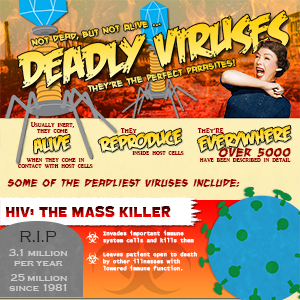Viruses are everywhere
Over 5,000 have been described in detail
Millions and Millions Exist
When they’re in the air, or on a doorknob
They’re inert = about as living as a rock.
When they come into contact with host cells
They trigger the cell to engulf them
Or fuse with the cell
Then use the cell’s machinery to reproduce
What is a virus?
Just a tiny bundle of RNA or DNA and a shell.
That uses host cells to reproduce itself.
And manifest some of the scariest illnesses on the planet.
HIV: the mass killer
Yearly Mortality: 3.1 million
Total Mortality: 25 million+ since 1981
How it works:
Invades important immune system cells and kills them.
Leaves patient open to death by other illnesses with lowered immune function.
Ebola: the rapid killer with no cure
Yearly mortality: Mortality rate: 90% within days[3]
How it works:
[3]Disables tetherin, a protein that disables the spread of the virus from cell to cell. Spreads rapidly to cause hemorrhaging, extreme fever, and death.
Rotavirus: the child-killer
Yearly Mortality:>500,000 children
How it works:
Spread through fecal-oral exposure, often through play surfaces or contaminated water. Diarrhea, vomiting, and abdominal pain can be deadly, particularly in the developing world.[4]
Smallpox: the monarch killer
Mortality rate: Eradicated
20th century mortality rate: 300-500 million
80% of infected children died
20-60% of infected adults.
How it works:
Localizes in the blood vessels of the skin and in the mouth and throat. One of two infectious diseases to be eradicated by humans. Ravaged populations from 10,000 b.c.- 1979. Killing 5 reigning monarchs in the 1700’s.
Hepatitis B: killing your liver
How it works:
The virus enters the bloodstream and heads for the liver. Once in the liver many other viruses activate and spread.[6]
Influenza: the pandemic that’s still around
Yearly Mortality: 500,000 deaths
Pandemics occur around 3 times a century.
How it works:
Attaches itself to receptors on cells in the lungs and air passages. As it takes over their machinery, the cells die. Dead cells cause runny nose, sore throat, and other symptoms.
Hepatitis C
Yearly Mortality: 56,000 deaths
200-300 million people infected.
How it works:
“Hepatitis” means inflammation of the liver, and it is in the liver where the Hepatitis virus replicates itself.
70% of patients develop chronic liver disease.[7]
15% cirrhosis
5% die from liver cancer or cirrhosis
Measles
Yearly Mortality: 197,000 deaths
Over last 150 years: 200 million deaths
How it works:
One of the most contagious viruses. Causes rash, high fever, and for weakened immune systems can be deadly.
Hantavirus: Because rats are dirty
yearly mortality: 70,0000 deaths
How it works:
Spread through rodent bites, droppings, or aerosolized rodent fecal matter. Can cause hemorrhaging and death.
Yellow Fever:The reemerging killer
Yearly Mortality: 30,000 deaths
How it works:
An acute hemorrhagic disease sometimes causing jaundice and living damage.
Dengue Fever: the break-bone fever
yearly mortality: 25,000 deaths
How it works:
[8]Spread by mosquitoes. Leads to severe pain in muscles, joints, and behind eyes. Occurs primarily in urban tropical areas.
Rabies
yearly mortality: 55,000 deaths
How it works:
[9]Enters the body and proceeds to the brain, replacing nerve cells in the process. By proceeding through the salivary glands it increases salivation, causing foaming at the mouth. This helps the virus spread through saliva. The most common form is the encephalitic or “furious” form of rabies in which agitation and aggression is heightened.
Viruses are aren’t truly even alive, but without proper care they can take your life.
Citations:
-
- http://archives.microbeworld.org/microbes/virus/
- http://www.medscape.com/viewarticle/807600_2
- http://www.sciencedaily.com/releases/2009/01/090127152838.htm
- http://www.historyofvaccines.org/content/articles/rotavirus
- http://www.ranker.com/list/the-top-13-most-incredible-viruses-on-earth/analise.dubner
- http://www.ccohs.ca/oshanswers/diseases/hepatitis_b.html
- http://www.medicinenet.com/hepatitis_c/page2.htm#what_is_the_nature_biology_of_the_hepatitis_c_virus
- http://www.bc.edu/schools/cas/biology/research/infect/dengue.html
- http://science.howstuffworks.com/zoology/all-about-animals/rabies1.htm

